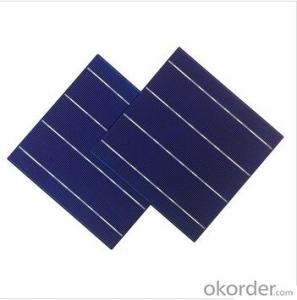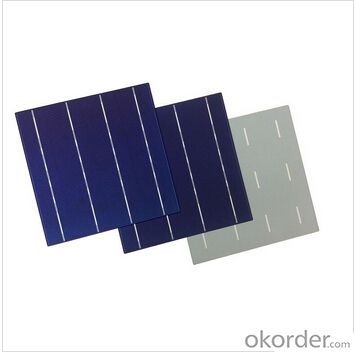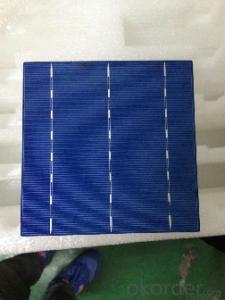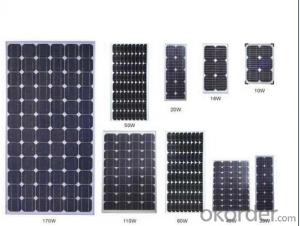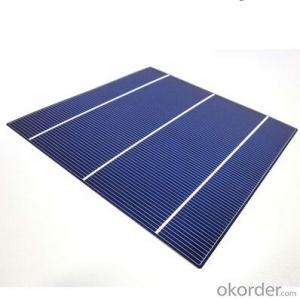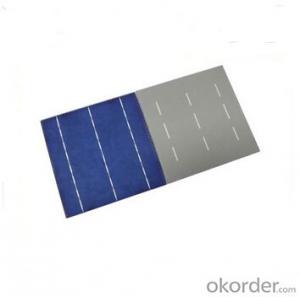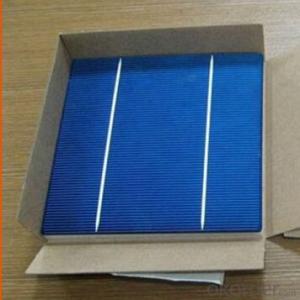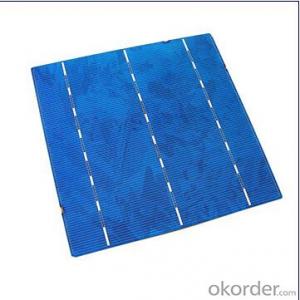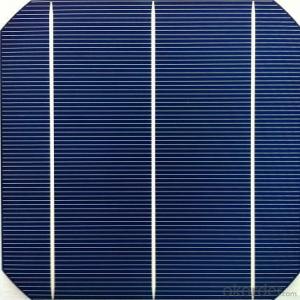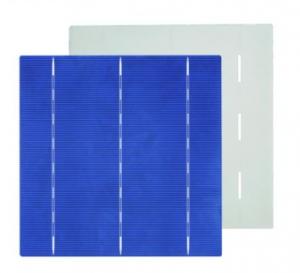High Quality 17.2% Polycrystalline Solar Cells for Space Applications
- Loading Port:
- Shanghai
- Payment Terms:
- TT OR LC
- Min Order Qty:
- 1000 pc
- Supply Capability:
- 1000000 pc/month
OKorder Service Pledge
OKorder Financial Service
You Might Also Like
Solar Cells:
solar cells, when struck by photons of light from the sun, generates an electrical current which can then be used to power DC or AC electrical loads.
A solar cell is made of silicon. Computer chips are made of this same material. Basically, when light strikes the surface of a solar cell some of it is absorbed into the silicon. This light energy bumps the electrons loose and causes energy to flow
Solar cells is made by solar wafer, it has three categories of solar cell right now, monocrystalline polycrystalline and thin film,These cells are entirely based around the concept of PN junction, which is the critical part of solar module, it is the part that can convert the light energy into electricity, the thickness is from 180um to 200um, with even busbars to conduct electricity, textured cell can decrease diffuse reflection; they are often electrically connected and encapsulated as a module. Photovoltaic modules often have a sheet of glass on the front (sun up) side, allowing light to pass while protecting semiconductor wafers from abrasion and impact due to wind-driven debris, rain, hail, etc. Solar cells are also usually connected in series in modules, creating an additive voltage. Connecting cells in parallel will yield a higher current;With high quality and stable quality. Our Cells can greatly improve the performance of Solar Modules.
Features:
High efficiencies up to 16.4%
Proven long term mechanical stability of silicone
Make of highly purified poly silicone
Three bus bars for reduced series resistance and improved module and cell efficiency
Blue anti-reflecting coating ensures improved light absorption and increased efficiency
Acid texturization offers a uniform appearance and virtually invisible crystal structure
Excellent low light behavior for improved energy yield
Specifications
Product Construction: | Epoxy Resin + Cell + PCB |
Maximum Output: | 4w |
Tolerance: | ±3% |
Maximum Output Power (Wmp) | 4w |
Max Working Voltage (Vmp) | 6v |
Max Charging Current (Imp) | 665ma |
Open Circuit Voltage (Voc) | 7.44v |
Short Circuit Current (Isc) | 720ma |
Cell efficiency(η): | 17.2% or above |
PCB | FR-4 |
PCB thickness(mm) | 1.6mm |
PCB color | Black |
PCB size(mm) | 165*165*2.7mm |
Product thickness: | 2.7mm |
Net Weight | 130g |
Barline: | Black tape or none |
Lifetime: | 1-3 years |
Storing temperature | 20°C ~ 60°C |
Working temperature | -20°C ~ 60°C |
Solar Cells Advantage:
1. High efficiency and High power.
2. Long-term electrical stability.
3. Lowest price and Fastest delivery.
4. Good quality and good service.
5.Bulk supply
6. Good Warranty
7.Big Sale
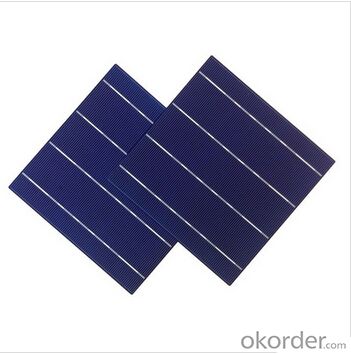
FAQ
We have organized several common questions for our clients,may help you sincerely:
①What price for each watt?
It depends on the efficiency of the solar cell, quantity, delivery date and payment terms.
②How long can we receive the product after purchase?
In the purchase of product within three working days, We will arrange the factory delivery as soon as possible. The pecific time of receiving is related to the state and position of customers.Commonly 7 to 10 working days can be served.
③Can you provide the peripheral products of the solar panels, such as the battery, controller, and inverter? If so, can you tell me how do they match each other?
Yes, we can, we have two companies for solar region, one is CNBM International, the other is CNBM engineering Co.
We can provide you not only the solar module but also the off grid solar system, we can also provide you service with on grid plant.
④What is your warranty of solar cell?
Our product can promise lower than 0.3% open box crack, we support claim after opening the box if it has crackm color difference or sth, the buyer should give pictures immediately, we can not accept the claim after the solar cell has assembled to solar panel.
• Timeliness of delivery
• ⑤How do you pack your products?
We have rich experience on how to pack the solar cell to make sure the safety on shipment, we could use wooden box or pallet as buyer's preference.
- Q: Can solar cells be damaged by hail or other weather events?
- Yes, solar cells can be damaged by hail or other severe weather events. Hailstones can potentially crack or shatter the surface of the solar panels, affecting their efficiency and functionality. Similarly, extreme weather events like hurricanes or heavy storms can cause physical damage by dislodging or breaking the panels, leading to a decrease in their performance. It is important to ensure proper installation and maintenance to minimize the risk of weather-related damage to solar cells.
- Q: What is the difference between a solar cell and a solar panel?
- A solar cell is a single unit that converts sunlight directly into electricity, while a solar panel consists of multiple solar cells connected together to generate a higher amount of electricity.
- Q: Can solar cells be used in camping or outdoor recreational activities?
- Yes, solar cells can be used in camping or outdoor recreational activities. They are portable and can be easily carried while camping, hiking, or engaging in other outdoor activities. Solar cells can charge various devices such as phones, cameras, and portable speakers, ensuring that you have power even in remote locations where traditional electricity sources may not be available.
- Q: How do solar cells handle dust storms or sandstorms?
- Solar cells are designed to handle dust storms or sandstorms by utilizing various protective measures. These measures include coating the surface of the solar panels with specialized materials that repel dust or sand, installing self-cleaning mechanisms that automatically remove any accumulated particles, and positioning the panels at an angle to allow the wind to blow away the dust. Additionally, regular maintenance and cleaning of the solar panels are essential to ensure optimal performance during such weather conditions.
- Q: Can solar cells be used for desalination?
- Yes, solar cells can be used for desalination. Solar energy can be harnessed by solar cells to power desalination plants that convert seawater or brackish water into freshwater through processes like reverse osmosis or multi-stage flash distillation. This sustainable approach reduces reliance on traditional energy sources and offers a potential solution to address the global water scarcity issue.
- Q: What is the effect of pollution on solar cell performance?
- Pollution has a significant negative effect on solar cell performance. Air pollution, such as smog and particulate matter, reduces the amount of sunlight reaching the solar cells, thereby reducing their efficiency. Additionally, pollutants like dust and dirt can accumulate on the surface of the solar panels, further decreasing their performance. Overall, pollution hampers the ability of solar cells to generate electricity effectively, highlighting the importance of clean environments for optimal solar energy production.
- Q: Can solar cells be used for off-grid power systems?
- Yes, solar cells can definitely be used for off-grid power systems. Solar cells, also known as photovoltaic cells, convert sunlight directly into electricity and can be used to generate power in remote locations that are not connected to the main power grid. These cells can be installed on rooftops, in open fields, or even on portable devices to generate electricity for various off-grid applications such as powering homes, cabins, or other remote facilities.
- Q: What is the efficiency of a solar cell?
- The efficiency of a solar cell refers to the percentage of sunlight it can convert into usable electrical energy.
- Q: How do solar cells affect the environment?
- Solar cells have a positive impact on the environment as they produce clean and renewable energy, reducing the reliance on fossil fuels and lowering greenhouse gas emissions. Additionally, the production and operation of solar cells have minimal environmental impact compared to conventional power generation methods. However, the manufacturing process of solar cells does require some resources and can generate waste, but overall, the environmental benefits outweigh these concerns.
- Q: Can solar cells be used in disaster recovery efforts?
- Yes, solar cells can be used in disaster recovery efforts. They are a reliable and sustainable source of energy that can provide electricity to power essential devices and equipment in disaster-stricken areas. Solar cells can be used to charge communication devices, provide lighting, run medical equipment, and support temporary shelters. Their portability and ability to operate off-grid make them particularly valuable in situations where traditional power sources are disrupted or inaccessible. Additionally, solar cells can contribute to reducing the reliance on fossil fuels during recovery efforts, promoting a cleaner and more sustainable path towards rebuilding communities affected by disasters.
Send your message to us
High Quality 17.2% Polycrystalline Solar Cells for Space Applications
- Loading Port:
- Shanghai
- Payment Terms:
- TT OR LC
- Min Order Qty:
- 1000 pc
- Supply Capability:
- 1000000 pc/month
OKorder Service Pledge
OKorder Financial Service
Similar products
Hot products
Hot Searches
Related keywords
